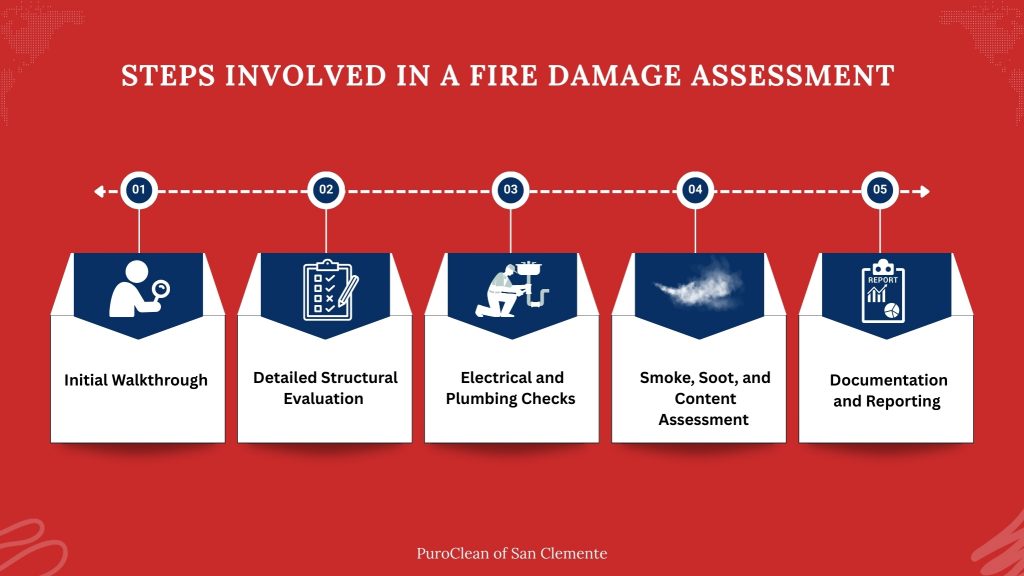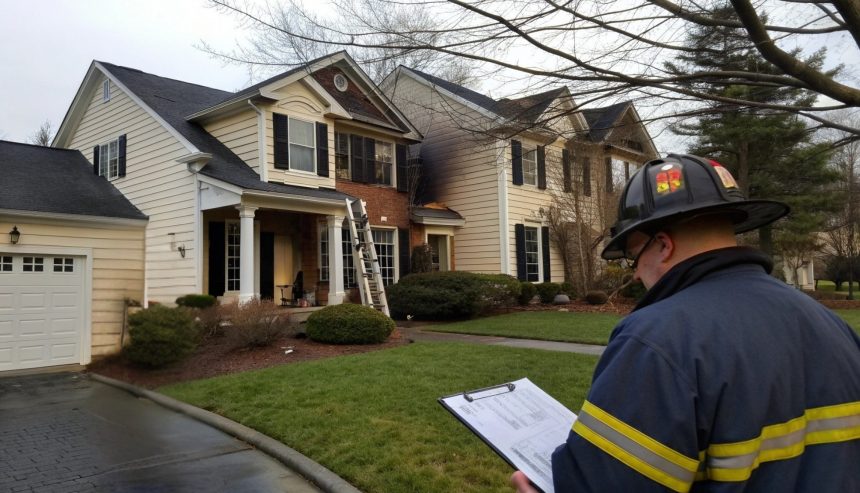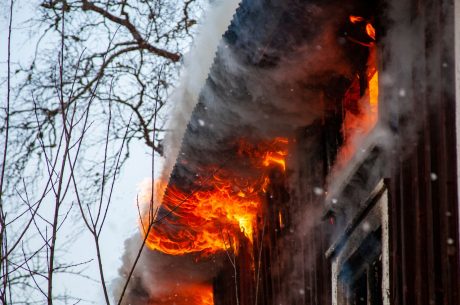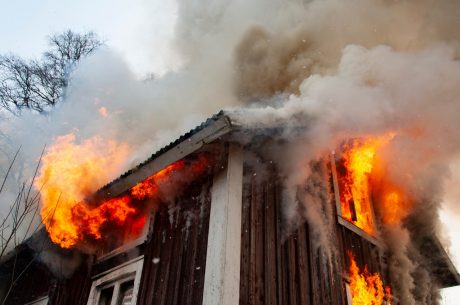Walking into a home after a fire can feel like stepping into a completely different world. The smell of smoke, charred belongings, and structural damage can be shocking, leaving you unsure where to start. Before jumping into repairs or cleanup, the first essential step is a fire damage assessment.
This process not only evaluates the extent of damage but also ensures your home is safe and provides the documentation needed for insurance claims and restoration. Understanding what happens during this assessment can turn confusion into clarity and help you make informed decisions about next steps.
Understanding the Fire Damage Assessment
A fire damage assessment is a comprehensive evaluation conducted after a fire incident to determine the full extent of damage to a property. Professionals check structural integrity, assess electrical and plumbing systems, and evaluate personal belongings for smoke or fire damage.
This process ensures that nothing is overlooked, guiding safe and effective restoration. It’s also important to consider the emotional impact of a fire, as homeowners often need guidance and support while navigating the recovery process, which experts can help provide. Typically, inspectors, restoration specialists, and insurance adjusters are involved.
Fire inspectors identify hazards and structural weaknesses, while restoration specialists evaluate salvageable materials and cleanable surfaces. Insurance adjusters use the findings to process claims efficiently. This assessment is a critical first step in creating a detailed restoration plan that addresses both safety and property recovery, and it is an essential part of the home fire inspection process that ensures every area of the property is thoroughly evaluated.
Steps Involved in a Fire Damage Assessment
The assessment process for fire damage follows a clear, step-by-step approach to ensure all areas of concern are addressed. Inspectors systematically examine the property to identify structural damage, safety risks, and salvageable items.
Every observation is documented, and preliminary recommendations are provided. Homeowners gain a clear understanding of what repairs will be needed and what can be saved. The process is a key part of the home fire inspection process, ensuring thorough evaluation from top to bottom.
Initial Walkthrough
The first step is a visual walkthrough, where inspectors identify immediate hazards, document fire and smoke damage, and take photographs. This step provides an initial overview of the property and helps prioritize urgent repairs. During this phase, inspectors also assess accessibility and safety concerns for future restoration work.
Homeowners are often briefed on what areas should be avoided until repairs begin. This walkthrough is an essential part of the home fire inspection process, ensuring that all critical areas are carefully evaluated.
Detailed Structural Evaluation
Inspectors then assess the foundation, walls, roof, and support beams for fire and heat-related damage. Even minor visible damage can indicate deeper structural concerns that require attention.
This evaluation ensures that load-bearing structures are stable before any restoration or cleanup begins. It also helps professionals determine if temporary reinforcements are needed to prevent further collapse or damage.
Electrical and Plumbing Checks
Electrical wiring and plumbing are evaluated for heat or fire damage. Damaged systems are identified to prevent further hazards such as electrical fires or leaks. Inspectors may test circuits, switches, and pipes to locate hidden issues that are not immediately visible. Early identification of these problems can prevent costly accidents during the restoration process.
Smoke, Soot, and Content Assessment
Inspectors review furniture, personal belongings, and surfaces for smoke and soot penetration. They determine which items can be cleaned and restored and which are beyond repair. This step is also part of the home fire inspection process, ensuring all affected areas are identified. Proper assessment here can save homeowners time, money, and potential health issues.
Documentation and Reporting
Finally, all findings are compiled into a detailed report with photographs, notes, and recommendations. This documentation is essential for insurance claims and planning the restoration process efficiently.
The report often includes suggestions for immediate safety measures and a recommended timeline for repairs. For more official guidance on assessment procedures, homeowners and professionals can refer to the FEMA Preliminary Damage Assessment Guide, which outlines standardized steps for evaluating property damage.

Common Questions During the Fire Damage Assessment
Many homeowners have practical questions about what to expect during a fire damage assessment. Understanding the timeline, involvement required, and the role of the assessment in restoration can help reduce stress. Inspectors provide guidance, answer questions, and offer preliminary cost estimates, ensuring homeowners are informed throughout the process.
How long does a fire damage assessment take?
The time varies by property size and damage severity, typically lasting from a few hours to a full day. More extensive damage may require additional inspections. Inspectors take the necessary time to carefully document all affected areas, including structural, electrical, and content-related damage. This thorough approach ensures nothing is overlooked and helps create an accurate restoration plan.
Do I need to be present during the assessment?
Homeowners are encouraged but not required to be present. Inspectors can complete the evaluation independently and provide a detailed report afterward. Being on-site, however, allows you to ask questions in real time and better understand the condition of your home.
It can also help you communicate specific concerns about certain areas or belongings that may need special attention, which helps ensure the home fire inspection process is completed thoroughly and accurately.
Will the assessment determine restoration costs?
Yes, the assessment provides a baseline estimate for repairs and insurance claims. While it is a preliminary figure, it helps in budgeting and planning the restoration process. The final costs may change as restoration progresses, but the initial estimate gives homeowners a realistic idea of what to expect. This information is essential for coordinating with contractors and ensuring insurance coverage aligns with actual repair needs.
Conclusion
A fire damage assessment is the first and most important step in recovering a home after a fire. It evaluates structural safety, electrical and plumbing systems, and the condition of personal belongings. This process also provides the documentation needed for insurance claims and ensures restoration work is based on accurate, professional evaluations.
By understanding the steps involved and what professionals look for, homeowners can approach restoration with confidence. Knowing what to expect during a fire damage assessment reduces uncertainty, helps prioritize safety, and sets the foundation for an organized and effective recovery plan.
FAQs
Q1. How long does a fire damage assessment take?
A: The assessment usually takes a few hours to a full day, depending on the size of the home and the severity of the damage. Larger or heavily damaged properties may require more time.
Q2. Do I need to be present during the assessment?
A: It’s recommended but not required. Inspectors can complete the evaluation on their own and provide a detailed report afterward. Being present allows you to ask questions in real time.
Q3. Will the assessment determine restoration costs?
A: Yes, the fire damage assessment provides a preliminary estimate for repairs and insurance purposes. Final costs may vary once full restoration work begins.



